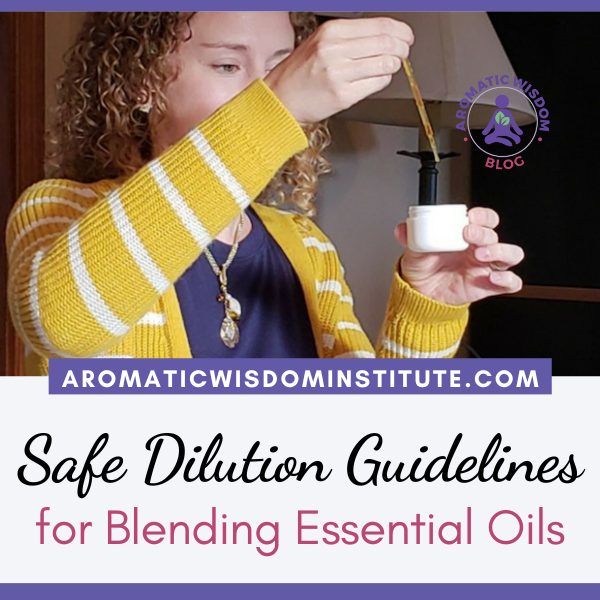Essential Oil Blending Guidelines and Dilution Chart
How to Dilute Essential Oils Safely and Effectively
Are you wondering how many drops of essential oil to use in your blend? Or how to dilute essential oils for sensitive skin, children, or pain relief? You’re not alone! Every week, I receive questions like:
“Liz, how strong should I make a blend for my husband’s sprained ankle?”
“Is it safe to use essential oils on my children—and how much should I use?”
“How many drops of essential oil should I add to my face cream?”
These are great questions because they show awareness that essential oils are potent and must be used safely. When applied topically without proper dilution, essential oils can cause skin irritation, sensitization, and other unwanted reactions.
The good news? Dilution is simple, effective, and safer for everyone. A few drops, when properly diluted in a carrier oil, can go a long way to support your wellness goals—without risking discomfort or harm.
In this guide, you’ll learn:
- Why essential oil dilution matters
- The best carrier oils to use to dilute your essential oils
- When not to use a carrier
- Safe essential oil dilution ratios
I’ve also included an easy essential oil dilution chart below
Let’s dive in!
Why Dilute Essential Oils?
Diluting essential oils with a carrier oil is the safest way to apply them topically. Here are four key reasons why you should always dilute:
-
Reduce risk of adverse reactions – Undiluted oils can irritate or sensitize the skin.
-
Use essential oils in a more sustainable manner – Dilution helps you conserve your oils, which are precious and concentrated.
-
Stretch your budget – Using fewer drops means your essential oils last longer.
-
Benefit from the carrier oil itself – Many carrier oils offer their own nourishing properties for the skin.
Common Carrier Oils for Essential Oil Blending
Here are a few of my favorite carrier oils to use when diluting essential oils:
🌿 Fractionated Coconut Oil
My go-to oil! It’s odorless, colorless, and has a virtually indefinite shelf life. It won’t interfere with your blend’s aroma and works beautifully for massage and roller blends.
🌿 Jojoba Oil (Liquid Wax)
Jojoba is technically a wax but acts like an oil. It mimics our skin’s natural sebum, making it perfect for facial and skincare blends. It has no scent and a very long shelf life.
🥑 Avocado Oil
Rich in vitamins A and D, this is a heavier, luxurious oil ideal for dry, mature, or irritated skin—especially soothing in winter months. Shelf life: about 1–2 years.
🌸 Sweet Almond Oil
Gentle, nourishing, and suitable for all skin types, including babies. However, avoid if you have a nut allergy.
🌹 Rosehip Seed Oil
This premium carrier is packed with antioxidants and is a top choice for mature skin, scar repair, and pairing with regenerative essential oils like Helichrysum (Helichrysum italicum).
When Not to Use a Carrier Oil
Some methods of using essential oils don’t require a carrier oil:
-
Diffusion: Carrier oils can damage your diffuser. Use pure essential oils only.
-
Nasal inhalers: Most people use undiluted oils on the wick, though a carrier can be added for gentler inhalation.
-
Inhalation from the bottle: No carrier needed—just breathe in directly from the bottle.
Safe Essential Oil Dilution Guidelines
Below is a general guide to help you dilute essential oils properly. Keep in mind that some oils have maximum dermal limits. Refer to Essential Oil Safety by Robert Tisserand for details.
⚠️ Special Safety Note:
-
Use caution with phototoxic essential oils (like certain citrus oils) when applying to skin exposed to sunlight.
-
Some oils should be avoided entirely when working with pregnant or breastfeeding women, children, or individuals with certain health conditions.
🎧 I go into detail about this in my podcast episode:
AWP 036: Phototoxic Essential Oils
Essential Oil Dilution Chart
This dilution chart shows how many total drops of essential oil to use based on the carrier oil volume and desired dilution percentage.
| Weight of Carrier | 1% Dilution | 2% Dilution | 3% Dilution |
|---|---|---|---|
| 1 oz (30 mL) | 5–6 drops | 10–12 drops | 15–18 drops |
| 2 oz (60 mL) | 10–12 drops | 20–24 drops | 30–36 drops |
| 4 oz (120 mL) | 20–24 drops | 40–48 drops | 60–72 drops |
What Dilution Should I Use?
-
1% Dilution – For children under 12, seniors, pregnant women, and those with chronic illness or sensitive skin.
-
2% Dilution – General wellness, skin care, and blends used daily.
-
3% Dilution – For short-term use (1–2 weeks) on pain, injuries, or during colds and flu.
Using Essential Oils Neat (Undiluted)
In general, I do not recommend using essential oils undiluted. However, exceptions can be made for:
-
Small areas
-
Acute situations (cuts, stings, bug bites, burns)
-
Short-term use only
-
High-quality, fresh, unoxidized oils
But even in these cases, use extreme caution. Long-term neat application can lead to sensitization.
Detailed Dilution Breakdown by Bottle Size
Here’s a breakdown of essential oil drops needed for common bottle sizes at different dilution percentages.
5 mL (1 tsp) Carrier Oil
-
1% = 1 drop
-
2% = 2 drops
-
3% = 3 drops
-
5% = 5 drops
10 mL (2 tsp) Carrier Oil
-
1% = 2 drops
-
2% = 4 drops
-
3% = 6 drops
-
5% = 10 drops
-
10% = 20 drops
15 mL (1 tbsp) Carrier Oil
-
1% = 3 drops
-
2% = 6 drops
-
3% = 9 drops
-
5% = 15 drops
1 oz (30 mL) Carrier Oil
-
1% = 6 drops
-
2% = 12 drops
-
3% = 18 drops
-
5% = 30 drops
2 oz (60 mL) Carrier Oil
-
1% = 12 drops
-
2% = 24 drops
-
3% = 36 drops
-
5% = 60 drops
4 oz (120 mL) Carrier Oil
-
1% = 24 drops
-
2% = 48 drops
-
3% = 72 drops
-
5% = 120 drops
📝 Note: Drop sizes can vary depending on viscosity and bottle design. Think of these numbers as flexible guidelines—not absolutes.
Final Thoughts on Safe Essential Oil Blending
Safe blending is empowering. When you understand how to dilute essential oils properly, you can create effective, personalized blends for skincare, wellness, and everyday health needs—with confidence.
🔗 Essential Oil Safety Guidelines
(or “Dumb Mistakes I’ve Made with Essential Oils”)
Have questions about a specific blend?
Ask me in the comments below—I’d love to help!
Get More Aromatic Wisdom Here👇👇👇





Very concise chart. I appreciate that. Question: Would there be anytime when you would go above a 3% dilution? Thank you.
Hi Irene,
This a great question and the answer is “yes”! This is when I go above 3%:
For specific injury for muscle, tendon, bone, you can use 3-10% depending on the individual, age, situation and oils being used. 3% dilution is the safest dilution to begin with.
For local issues such as chest congestion you can use 3-10% again, depending on the individual, age, situation and oils being used.
If problem is acute and severe, you can go up to 25% dilution for short-term use, but I rarely find the need to use this much oil. (These problems include severe muscle cramps, intense spasms, significant bruising or pain.)
It really doesn’t take much essential oil to positively affect an area.
Thanks for asking Irene!
I am taking my first aromatherapy class. The table is so helpful. Question I have is if you are making a blend of oils, is there a table that provides each essential oils blending factor? Other than the concept of high, middle and low notes blending (which I have yet to wrap my head around), is there an easier way to blend oils for specific needs, i.e., muscle aches blend?
My question is whether or not you know the blending factor for the full list of oils used in aromatherapy and if it is not available through this website, do you know where that information can be located. Most websites that provide essential oils do not list the blending factor for each, though it may include whether it is a high or a low. It is almost impossible to find a blending factor chart, and most that are offered online are dilution ratios, not blending factors.
Hi Jennifer, I’d love to be able to help. Can you clarify what you mean by “blending factors”? I have always considered dilution ratios the primary considering for creating a formula because it is a safety issue. With “blending factors” is something else taken into consideration?
Does it make a difference if you’re blending in a solid form (like shea, etc)?
Also, does this apply to all oils (some are more dense than others). Is there a rule of thumb for the amount of oil to use for top, middle & high notes?
Thank you!
Hi,
Can you tell me what a blending sheet is please as I have to complete one for my aromatherapy course.
Kind Regards
Maggie
Hi Maggie, A blending sheet is simply a paper where you write down the recipe for your blend with oils, number of drops, dilution ratio and anything else you want to record about the blend. We use one in my classroom, but I’m sure the teacher of your aromatherapy course has one. If you’d like, I have a great journal on Amazon that I created specifically for people like you 🙂 It is called My Books of Blends” You can find it on Amazon Here: MY BOOK OF BLENDS.
I love your book Liz. It’s has become my own little book of treasured blends. It’s wonderful to have a place to record all of my “concoctions” and make notes on them.
Awwwww that’s warms my heart Hope! Thank you for sharing 🙂
This is an absolutely helpful website. The information is stated so clearly.
thank!
Thank you so much, this is such a super handy chart, especially for a beginner!
Just learning all this fun educational issues. See if I understand this correctly. If I have a recipe that has 3 essential oils and it says 10 drops each that would be 2 oz carrier 3% dilution What is the dilution for roller bottle then. I think I made mine to strong. It was 4 EO – 20 drops of each. Then filed with coconut oil
Was for my 3 year shingle pain. It works great. Not got but it relieves the pain if use in morning and night… After 3 years I can sleep on my right side now with no pain.. Do you think I can use this strength long term… Thank you for you time.
Very helpful and easy to understand. Staying in the limits of the chart, makes the use of essential oils safe.
Thanks for this information!
Thanks for stopping by! I agree…being a visual person, I love charts – or anything that I can see at a glance!